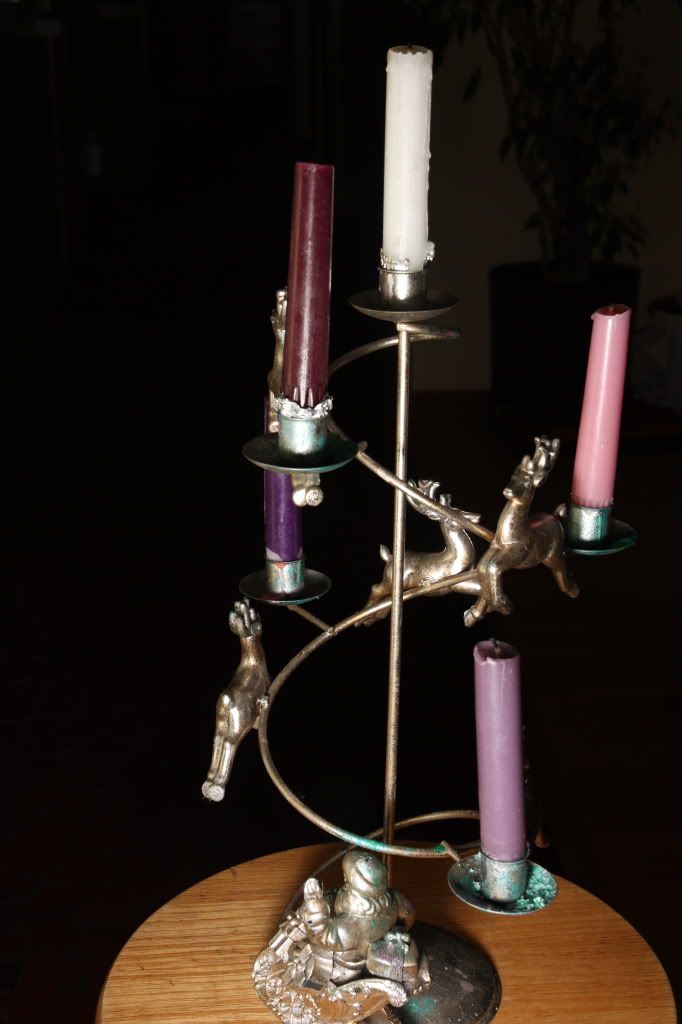I was asked two related questions by parish friends this week, and I answered incorrectly:
- What things do we do to help our kids “Keep Christ in Christmas”?
- What are we doing for Advent?
I thought the answer to both was: Nothing. This year, anyway.
I was sorely mistaken. Since both these are going to be discussion topics for our Family Fellowship group this week, here are my notes so I can keep my facts straight. These are things we do, and which have held together through the years, and which I think are probably helpful. Some are easy for anyone to do, some of them maybe not.
#1 Be a Disciple of Jesus Christ
When the SuperHusband and I first became Christians, I was a little disconcerted to notice how little our extended family’s observances of the feast involved any particular worship of Christ. It had not bothered me before, but now somehow it seemed wrong to gather together for a meal and gifts and not much Jesus-ing. A lot of years later, I’m not bothered. Those of us who are Christians get plenty of Jesus-ing all year long, including Christmas Eve and Christmas Day, and we don’t need every single moment of every single feast to have a little cross tacked on it.
(For the record, there is a very Christian grace before the big extended-family supper Christmas Eve and plenty of Christian-household backdrop going on. We’re not celebrating Festivus or something.)
My point is this: When every day and every week of your life is built around the worship and service of Jesus Christ, there’s not a need to make sure your wrapping paper has manger scenes on it. Both the “Christ” and the “Mass” in “Christmas” are patently obvious. Forgetting that Christmas was about the birth of Christ would be like forgetting what your own birthday was about. It’s unlikely to be problem.
#2 Dang I Love My Parish
My DRE has a passion for keeping Advent, and the pastor’s completely on board. (Yes, it unrolled in that order — she predates him on the staff roster.) Rather than rushing to quick celebrate Christmas with the kids before the break, there are Advent events throughout Advent, and Christmas is unleashed on — get this — Christmas. The religious ed classes host Christmas parties the first class back after the break, while it’s still Christmas season.
This is not just good for holding onto Catholic liturgical order. This is good because it causes us all to be keenly aware we are out of sync with the wider culture, and therefore aware of what we’re doing and why we’re doing it. It also gives me a little bit of ammo in my effort to keep things purple around the house, though admittedly that’s push-and-pull. Yes, in fact we do have the best Advent Lights on the block. That’s my story and I’m sticking to it.
But I would say the biggest help we get in terms of the parish enthusiasm for observing Advent is that it completely prevents our brains from equating what we do as Catholics with that merchandising event going on at the mall.
#3 We’ve got a great Advent calendar.
The one we happen to own is the Tony Wolf Advent Calendar, which I reviewed when I first got it years ago. Each day from December 1st through 24th there is a mini boardbook ornament that contains a Bible story, prayer, hymn or carol. All put together you get the highlights of the story of Christmas from Adam and Eve forward. There is no Christmas Advent tree up yet this year, so I told my ten-year-old to hang the ornaments on the hooks on the mantel where our stockings will eventually go.
She loves this. She loves reading aloud the day’s mini-book, singing along if it’s a hymn, and keeping all the ornaments organized on their hooks. The other kids are older now, so the ten-year-old’s the chief user. I remember myself having a little mini-book Christmas ornament and how much I liked to read it (mine was The Night Before Christmas). Bite-sized books are captivating.
There are other similarly good options, it doesn’t have to be this exact product. I remember growing up that my best friend’s family had a homemade Advent calendar with pertinent Bible verses for each day — same principle. I think the takeaway here on why this concept works so well is that kids like to open a new thing every day, so they bring the momentum to the daily observance, and the day’s thing isn’t just a piece of chocolate or a picture from a snowy village, it’s a piece of the Good News.
#3.5 We Stink At Advent Wreaths, Forever and Ever Amen
For your amusement, here’s a photo from a glorious Advent past:
I would have kept the thing, but it was too bulky to store easily. This year we’ve got an assortment of mismatched white candles with purple or pink ribbon tied around the base. We never remember to light them.
I’m completely in favor of Advent wreaths. I have happy childhood memories of lighting the candles at dinner every evening. We just aren’t there. Sorry.
#4 But We’re Good at Caroling!
Way back before we had kids, the SuperHusband and I started up hosting an annual caroling party. It’s easy and fun and you can do it too.
As we dropped the ball on this one in recent years, some friends have picked up the relay. Mrs. A who first started hosting an Advent tea party every year (most years) when our girls were little has merged that tradition with a potluck supper and caroling party afterwards. It’s a good event. We stick to classic Christian carols (Silent Night, We Three Kings, What Child Is This, etc.) plus We Wish You a Merry Christmas. We only plague neighbors who show evidence of celebrating Christmas, so we’re not foisting our zeal on innocent bystanders. The response has been 100% positive.
We’re up to 4/6ths of the family now singing in some choir or another at church, so the kids get a strong dose of sacred music there as well. We go to one of those parishes where the songs are all about Jesus, which is a big boost.
#5 Jesus Fairyland
Or Bethlehem, as you prefer. Way back at the time of our first caroling party (before kids), I didn’t have a nativity set, so I made one out of Lego bricks. Since that time we’ve added humans to the family and all kinds of toys. Playmobil. Fisher Price. Little Woodzees. All that stuff. Thus we have evolved an annual tradition of creating not just the manger scene but a good bit of Bethlehem and environs.
We’ve had years that featured Herod’s castle and a Roman circus (the better to eat you with, my dear), though the best was during the preschool years when we had the big red barn with the door that mooed. A traditional nativity set can sometimes look too much like Camping with Baby Jesus — Pass the S’mores. The circumstances of the Incarnation hit home more soundly when you’ve got a neighborhood of cozy cheerful dollhouses, and then the Holy Family camped out in what truly looks to modern eyes like a place only fit for farm animals.
This year, having just pared back the toy collection, we’re focusing on the unrolling of the historic events day by day. Right now the angels are all up in Heaven, at the top of the bookshelf in front of the vintage Hardy Boys collection, waiting for the big day. (That is what Heaven is like, right?) Mary and Joseph are in a caravan headed towards the city of David. The Wise Men are still home watching the sky. The stable is busy being just a stable, though the innkeeper — you might remember this from your Bible study — likes to come by every day and visit with his pet bunnies. St. Ignatius Montessori, pray for us.











 .
.


